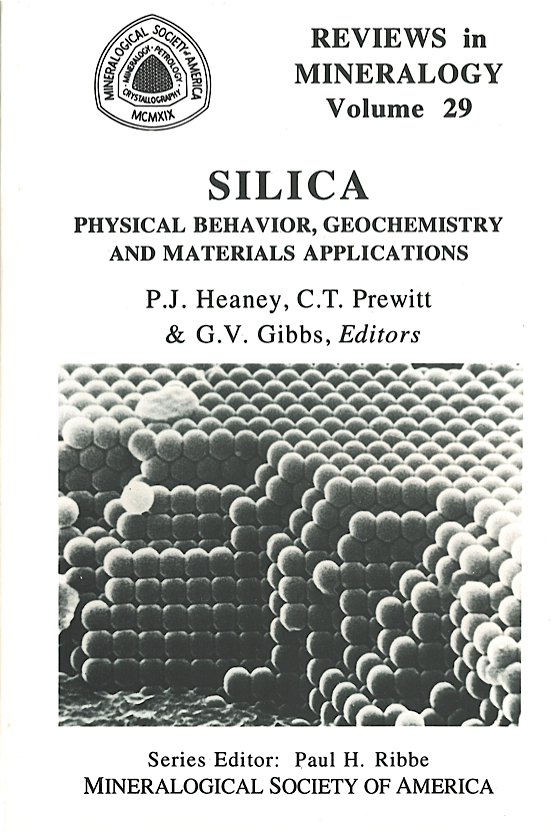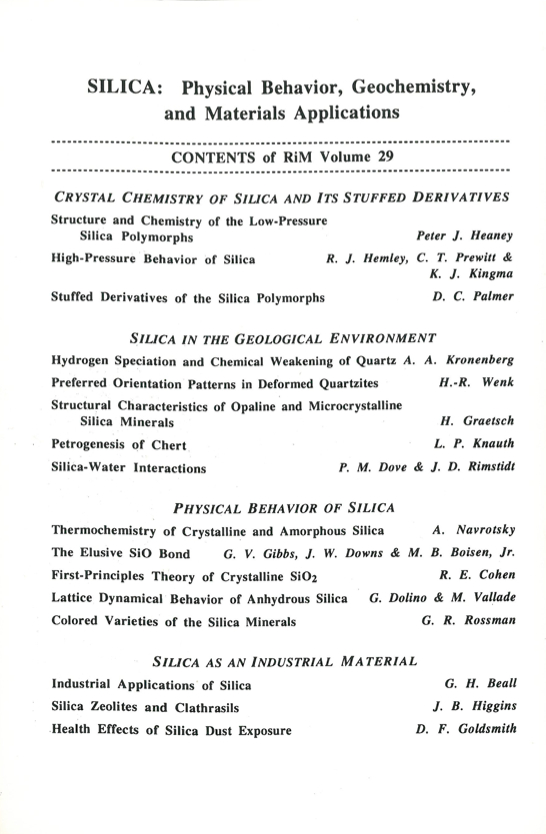

Mineralogical Society of America, Founded December 30, 1919
Order Publications Online (25% discount for MSA, CMS and GS members, except shipping)
MinPubs.org Pay-Per-View GeoScienceWorld Pay-Per-View


1994, i-xviii + 606 pages. ISBN 0-939950-35-9; ISBN13 978-0-939950-35-5
Oxygen and silicon are the two most common elements in the earth's crust, together constituting an estimated 74.32 weight % and 83.77 atom % of crustal rocks (Mason and Moore, 1982). Thus, it is not surprising that SiO2 or silica, is the most abundant oxide on the earth's surface. In his widely cited survey, Clarke (1904) calculated that quartz alone comprises 12.0% of the crust by volume, ranking behind the mineral groups that include feldspar (59.5%) and amphibole/pyroxene (16.8%). Consequently, research into the silica system is motivated foremost by the prevalence of silica in man's immediate environment. The ubiquity of silica in igneous, metamorphic, and sedimentary rocks has led earth scientists to seek its uses as an indicator of large-scale geological processes, ranging from mountain-building to meteorite impacts. In industry, quartz has long played a prosaic but essential role as an inexpensive and relatively inert constituent of concrete aggregates, and modern electronics technology still relies on quartz oscillators. Silica phases also have played a prominent role in our understanding of the solid state. Physicists first discovered optical activity in crystals and the existence of soft modes during their investigations of quartz.
Many scientists have written substantial reviews documenting the importance of silica in the earth, materials, and physical sciences. Notable among these are Robert Sosman, who followed his Properties of Silica (1927) with The Phases of Silica (1965), and Clifford Frondel, who devoted the third volume of Dana's System of Mineralogy (1962) exclusively to the silica minerals. These treatises continue to serve as encyclopedic resources for those interested in silica, and their historical analyses and descriptions of mineral varieties, morphologies, and localities will remain forever useful. Nevertheless, the past three decades have witnessed a first-order expansion of our knowledge of the silica system, and it is time to provide an updated silica review. The present volume focuses on the most recent developments, and it is intended to supplement rather than replace the earlier works of Sosman and Frondel.
The contributions to this volume cover silica chemistry in the following fashion:
Peter J. Heaney, Princeton, New Jersey, USA
September 1, 1994
REFERENCES
Clarke FW (1904) Analyses of rocks from the laboratory of the United States Geological Survey, 1880 to 1903. Bull U S Geol Surv 228
Frondel C (1962) System of Mineralogy, 7th edn. Vol. 3. John Wiley, New York
Mason B, Moore CB (1982) Principles of Geochemistry, 4th edn. John Wiley, New York Sosman RB (1927)
The Properties of Silica. Chemical Catalog Co., New York
Sosman RB (1965) The Phases of Silica. Rutgers Univ Press, New Brunswick, NJ
Title Page
p. i
Copyright
p. ii
Foreword, Preface & Acknowledgements
p. iii - vi
Table of Contents
p. vii - xviii
Chapter 1. Structure and Chemistry of the Low-Pressure Silica Polymorphs
by Peter J. Heaney, p. 1 - 40
Chapter 2. High-Pressure Behavior of Silica
by Russell J. Hemley, Charles T. Prewitt, and Kathleen J. Kingma, p. 41 - 82
Chapter 3. Stuffed Derivatives of the Silica Polymorphs
by David C. Palmer, p. 83 - 122
Chapter 4. Hydrogen Speciation and Chemical Weakening of Quartz
by Andreas A. Kronenberg, p. 123 - 176
Chapter 5. Preferred Orientation Patterns in Deformed Quartzites
by Hans-Rudolf Wenk, p. 177 - 208
Chapter 6. Structural Characteristics of Opaline and Microcrystalline Silica Minerals
by Heribert Graetsch, p. 209 - 232
Chapter 7. Petrogenesis of Chert
by L. Paul Knauth, p. 233 - 258
Chapter 8. Silica-Water Interactions
by Patricia M. Dove and J. Donald Rimstidt, p. 259 - 308
Chapter 9. Thermochemistry of Crystalline and Amorphous Silica
by Alexandra Navrotsky, p. 309 - 330
Chapter 10. The Elusive SiO Bond
by Gerald V. Gibbs, James W. Downs, and Monte B. Boisen Jr., p. 331 - 368
Chapter 11. First-Principles Theory of Crystalline SiO2
by Ronald E. Cohen, p. 369 - 402
Chapter 12. Lattice Dynamical Behavior of Anhydrous Silica
by Gerard Dolino and Marcel Vallade, p. 403 - 432
Chapter 13. Colored Varieties of the Silica Minerals
by George R. Rossman, p. 433 - 468
Chapter 14. Industrial Applications of Silica
by George H. Beall, p. 469 - 506
Chapter 15. Silica Zeolites and Clathrasils
by John B. Higgins, p. 507 - 544
Chapter 16. Health Effects of Silica Dust Exposure
by David F. Goldsmith, p. 545 - 606